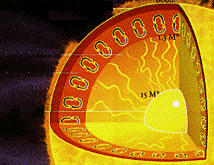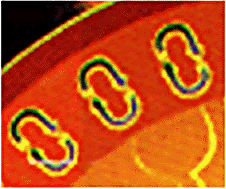


|
Pictured on the left is the Sun in cutaway: the core
(yellow-white) is in the centre
and surrounded by the radiative zone (yellow). Surrounding that is
the convective zone. In the convection zone, the gas is too cool (although it is still around 2,000,000 degrees!) to let the radiation pass through easily. Instead, the cool ions absorb the radiation. This heats up the plasma. When the plasma is heated it becomes less dense (just like hot air always rises) than its surroundings and so rises upwards away from the heat source. We say then that the energy has been convected away. |
| As the hot, less dense plasma rises, the cooler, more dense plasma above it sinks. This sets up convection currents in the Sun (see the diagram on the right). The cooler plasma will sink to the base of the convection zone and get heated. Meanwhile, the hot plasma that has moved up will begin to lose its heat energy and so cool, become more dense and sink back down again. This cycle runs continuously, transferring heat energy from the top of the radiative zone to the next layer of the Sun. |

|

 
|
Energy Home Page | 

|